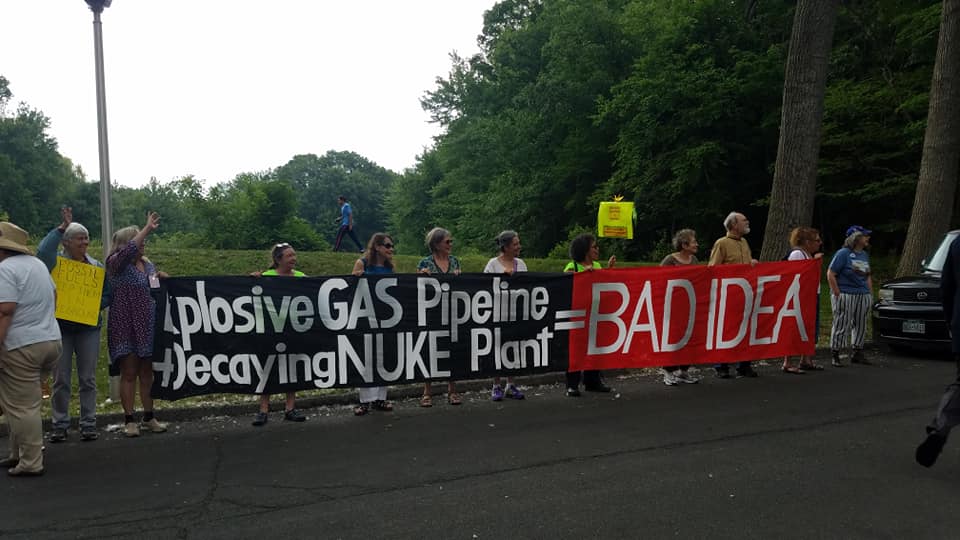Activists’ Fears Confirmed by Newly Released New York State Multi-Agency Report Showing Dangers of Siting AIM Pipeline Next to Indian Point Nuclear Facilities
by ResistAim
Croton-On-Hudson, NY Sunday, June 24, 2018 — Residents of towns near the Algonquin Incremental Market (AIM) pipeline gathered today at a fundraiser where Governor Cuomo was scheduled to appear, to tell the Governor to immediately shut the “Algonquin” Pipeline down. Today’s protest is a response to the New York State multi-agency Risk Assessment regarding co-locating a high pressure, high volume fracked gas pipeline alongside the failing Indian Point Nuclear Power Plant; the report was due over a year and a half ago and its executive summary was released on Friday evening. This report substantiates arguments made for years by community members, experts, and elected officials that the Federal Energy Regulatory Commission (FERC) did not sufficiently consider risks and other concerns before constructing the “Algonquin” Incremental Market (AIM) Pipeline expansion alongside Indian Point.
In February 2016, the Governor ordered the New York State Department of Homeland Security and Emergency Services (DHSES), Department of Public Service (DPS), Department of Health (DOH), and the Department of Environmental Conservation (DEC) to undertake the Risk Assessment. Last year, construction was completed on the AIM Project, a high-pressure, 42’ inch diameter, fracked gas pipeline that runs under the Hudson River and within 110 feet of critical safety infrastructure for the aging and failing nuclear plant. The pipeline was completed after years of protest from the community and beyond, and in direct opposition to objections from elected officials at all levels. Further, this pipeline was built despite a report from the Massachusetts Attorney General showing that the additional capacity was not needed for the region to meet its energy needs.
While Governor Cuomo was a no-show at the event, activists did speak with Lieutenant Governor Kathy Hochul, demanding the state act immediately now that it has evidence of the risks posed by the pipeline. Despite attending the fundraiser only a few miles from the plant, the Lieutenant Governor said she wasn’t well versed on the topic and couldn’t speak to the state’s next steps. “How can the Lieutenant Governor attend an event only a stone’s throw from the plant and not be aware of the risk assessment that was released only 48 hours ago saying the home she was standing in was in danger?” asked Courtney Williams, a Peekskill resident who attended the rally with her young daughter. “We’ve been pressing the state on this for years. The fact that she was unable to speak to us about this is just more evidence that New York State isn’t doing its due diligence to protect us.”
“For years we have been saying that none of the Federal agencies were evaluating all the necessary risks when they granted permits for this pipeline. The Risk Assessment executive summary released on Friday is clear evidence that an independent contractor and four State agencies agree that there are too many unanswered questions to accurately assess the risk of running a high pressure, fracked gas pipeline right by Indian Point. The Governor must stop the the flow of gas at least as long as so many questions remain unanswered,” said Amy Rosmarin, co-founder of Stop the Algonquin Pipeline Expansion (SAPE).
“This Risk Assessment could have been completed and released before the AIM Pipeline construction was finished,” said Tina Volz-Bongar, from Resist Spectra. “Now we are in a situation where gas is flowing through a pipeline for which proper safety determinations were not made. We are calling on the Governor to go to FERC and ask for an immediate stay to halt the gas flow alongside and under Indian Point,” she continued.
“Given what the Risk Assessment says, it is incumbent upon the Governor to direct the Public Service Commission to use its authority under PHMSA (Pipeline Hazardous Materials and Safety Administration) to turn off the AIM Pipeline and do a proper safety and risk assessment without residents living daily with the potential danger of fracked gas under the plant,” said Nancy Vann, co-founder of Safe Energy Rights Group (SEnRG).
Today, community members and groups called on the Governor to shut the pipeline down by directing the Public Service Commission to exercise its authority over pipelines under PHMSA (Pipeline Hazardous Materials and Safety Administration).
“While the probability of pipeline incidents is low, the proximity to the Indian Point nuclear plant makes the potential consequences of such an event very significant,” said the agencies in their press release. “Additional scrutiny and monitoring to better understand and reduce risks associated with the Algonquin pipelines is warranted. FERC must engage in further action to mitigate and investigate potential risks.”

